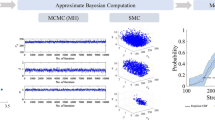Abstract
Based on the weakest-link model, a family of fiber strength distributions is investigated assuming a two-stage failure process. At the first stage, a weakest link is formed (instantly or gradually), but at the second one the fracture of this link takes place. The gradual accumulation of flaws is described with the aid of Markov chain theory. The adequacy of the models considered is verified by checking them against experimental strength data for E-glass and flax fibers of various lengths. It is found that the models are not less accurate, but are even better, in a number of cases, than the model based on the known modified Weibull model with a power-law relation between the fiber length and the scale parameter.
Similar content being viewed by others
References
F. T. S. Pierce, J. Text. Inst., 17, 355 (1926).
W. A. Weibull, “A statistical theory of the strength of materials,” Proc. Roy. Swed. Inst. Eng. Res., No. 151 (1939).
H. E. Daniels, “The statistical theory of the strength of bundles of threads,” Proc. Roy. Soc. London, A183, 405–435 (1945).
C. Zweben, “Tensile failure of composites,” AIAA J., 12, 2325–2331 (1962).
C. Zweben and B. Rosen, “A statistical theory of material strength with application to composite materials,” J. Mech. Phys. Solids, 18, No. 3, 189–206 (1970).
M. A. Kleinhof, Investigation of the Static and Fatigue Strength of Composite Materials Used in Structures of Flying Vehicles, PhD Thesis [in Russian], Riga (1983).
Yu. Gutans and V. P. Tamuzh, “To the scale effect of Weibull distribution of the strength of fibers,” Mekh. Kompozit. Mater., No. 6, 1107–1109 (1984).
A. S. Watson and R. L. Smith, “An examination of statistical theories for fibrous materials in the light of experimental data,” J. Mater. Sci., 20, 3260–3270 (1985).
W. J. Padgett, S. D. Durham, and A. M. Mason, “Weibull analysis of the strength of carbon fibers using linear and power law models for the length effect,” J. Compos. Mater., 29, No. 14, 1873–1884 (1995).
W. A. Curtin, “Tensile strength of fiber-reinforced composites: III. Beyond the traditional Weibull model for fiber strengths,” J. Compos. Mater., 34, No. 15, 1301–1332 (2000).
J. Andersons, R. Joffe, M. Hojo, and S. Ochiai, “Glass fibre strength distribution determined by common experimental methods,” Compos. Sci. Technol., 62, 131–145 (2002).
J. Andersons, E. Sparnins, R. Joffe, and L. Wallstrom, “Strength distribution of elementary flax fibers,” Compos. Sci. Technol., 65, 693–702 (2005).
W. F. Knoff, “Combined weakest link and random defect model for describing strength variability in fibers,” J. Mater. Sci., 28, 931–941 (1993).
Yu. Paramonov and J. Andersons, “A family of weakest link models for fiber strength distribution,” (submitted to Composites A).
Standard Test Method for Tensile Strength and Young’s Modulus for High-Modulus Single-Filament Materials, ASTM D 3379-75.
E. Gumbel, Statistics of Extremes [Russian translation], Mir, Moscow (1965).
Author information
Authors and Affiliations
Additional information
__________
Translated from Mekhanika Kompozitnykh Materialov, Vol. 42, No. 2, pp. 179–192, March–April, 2006.
Rights and permissions
About this article
Cite this article
Paramonov, Y., Andersons, J. A new model family for the strength distribution of fibers in relation to their length. Mech Compos Mater 42, 119–128 (2006). https://doi.org/10.1007/s11029-006-0023-6
Received:
Issue Date:
DOI: https://doi.org/10.1007/s11029-006-0023-6




